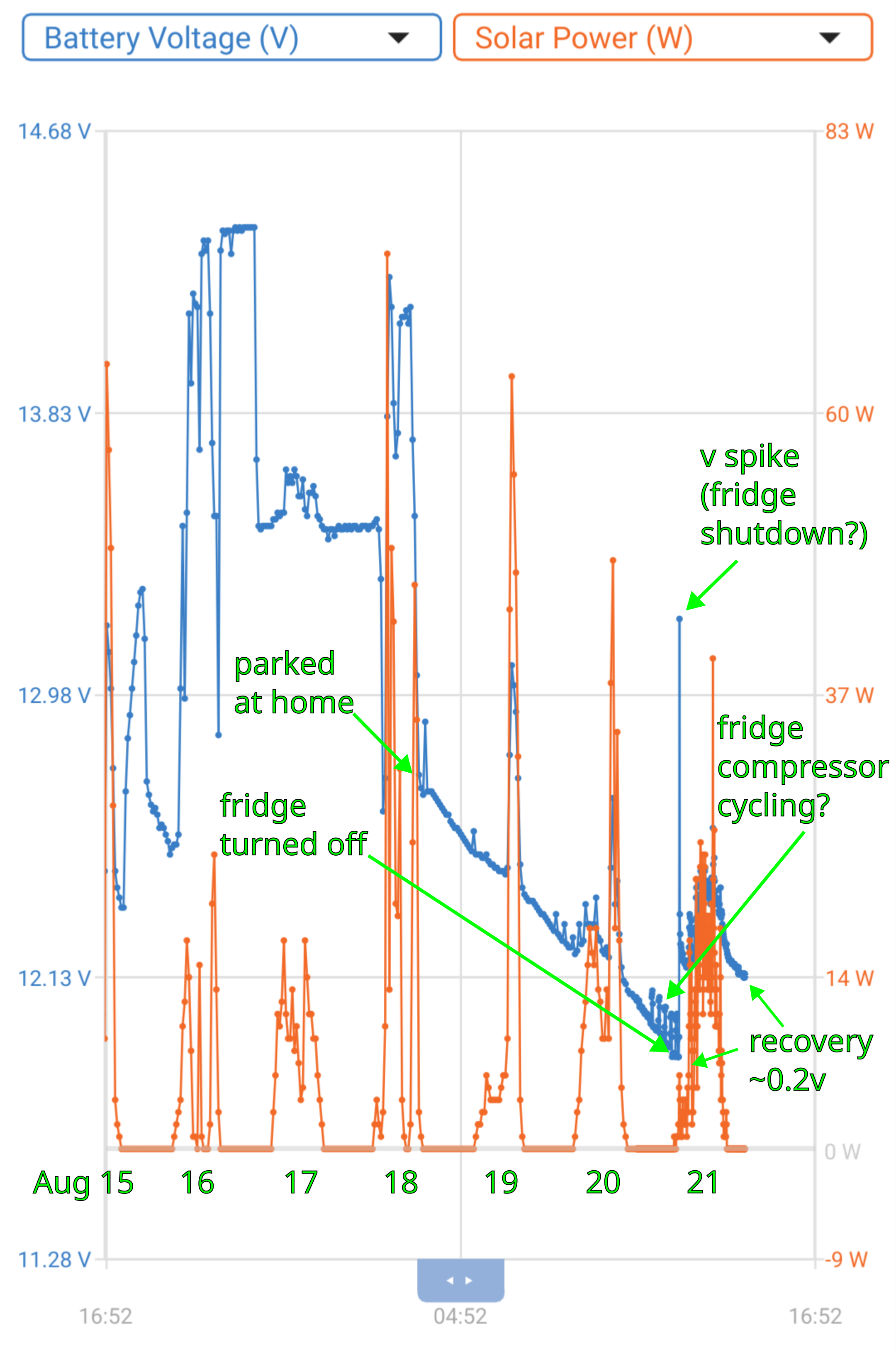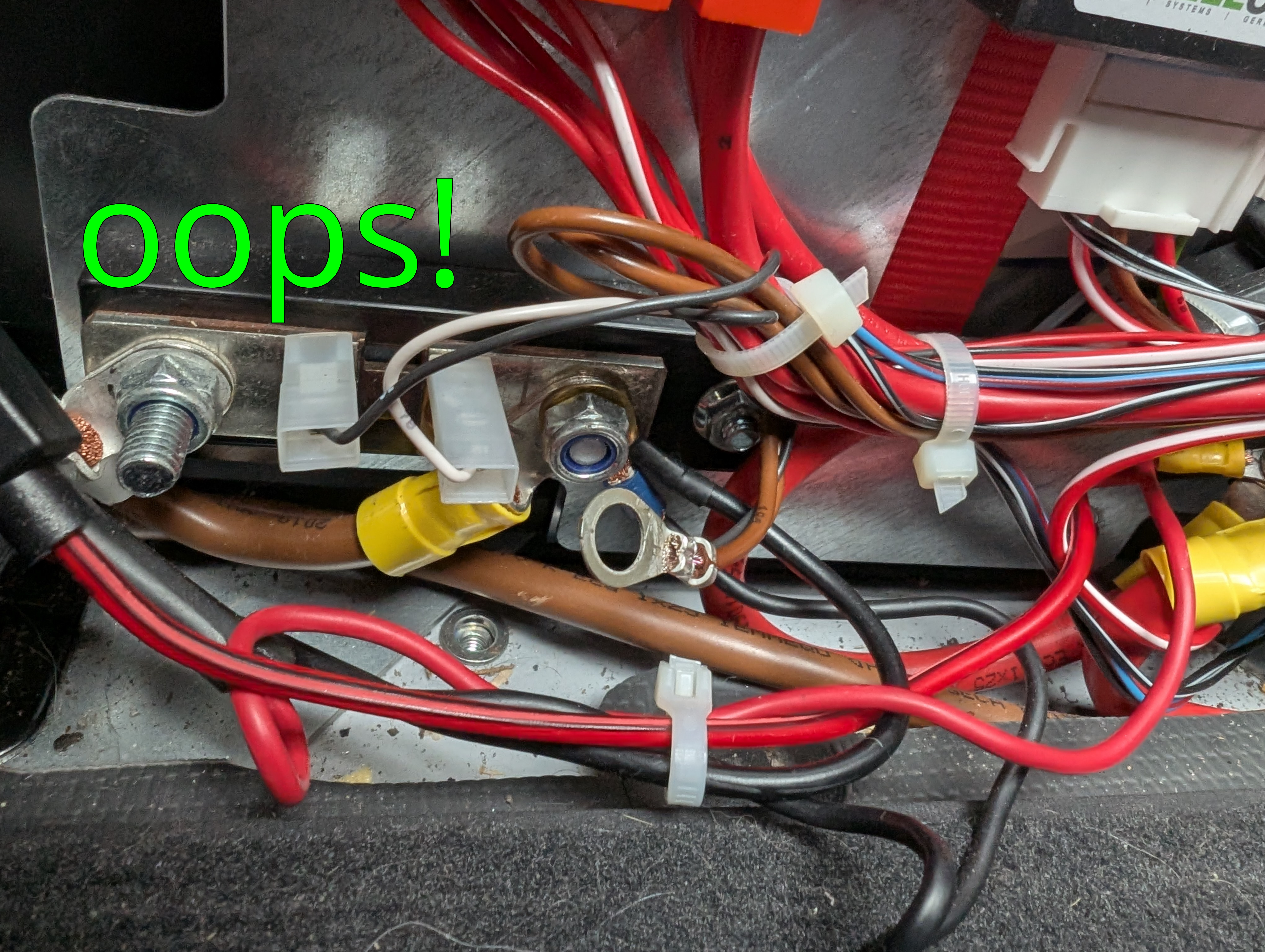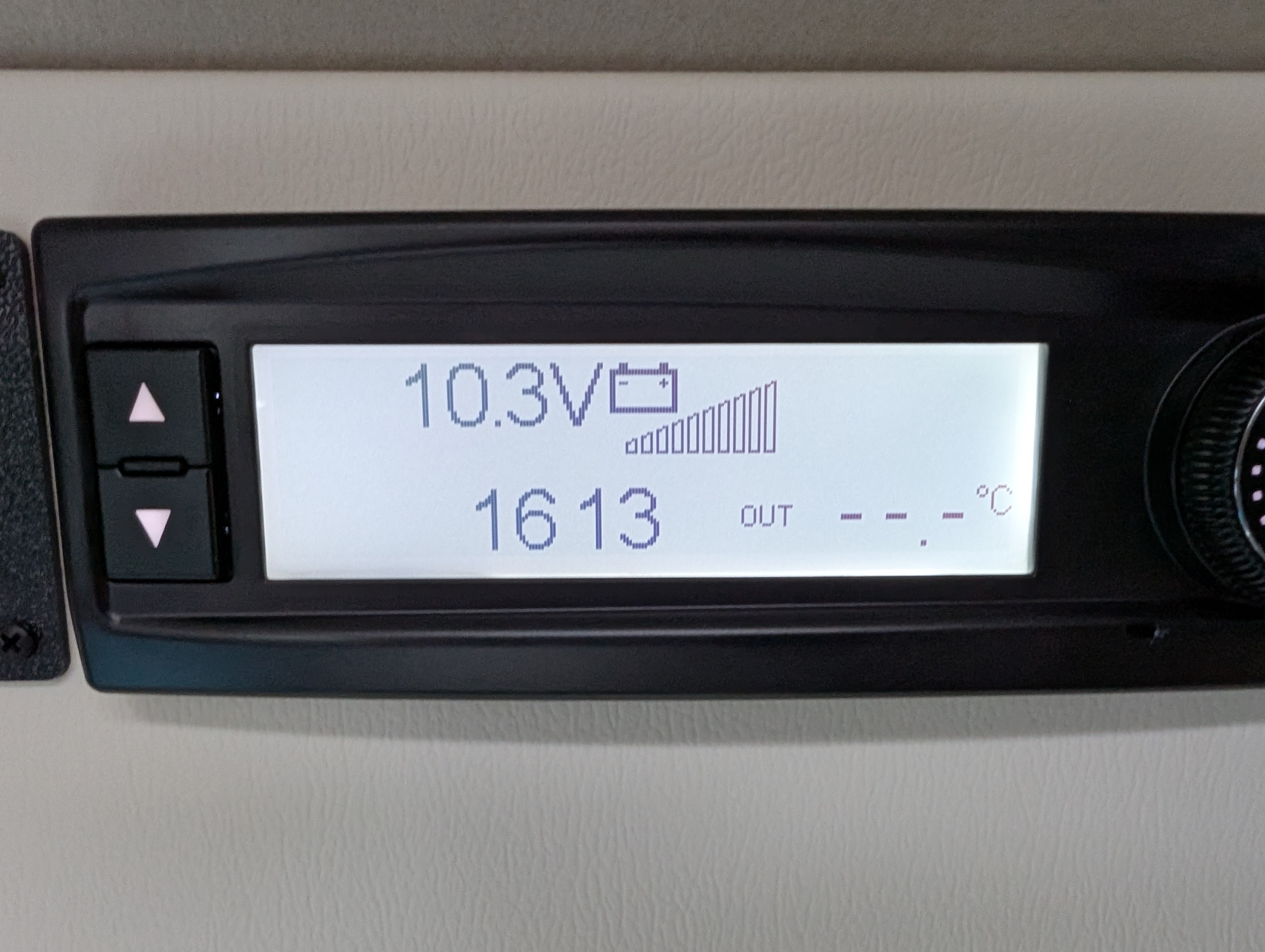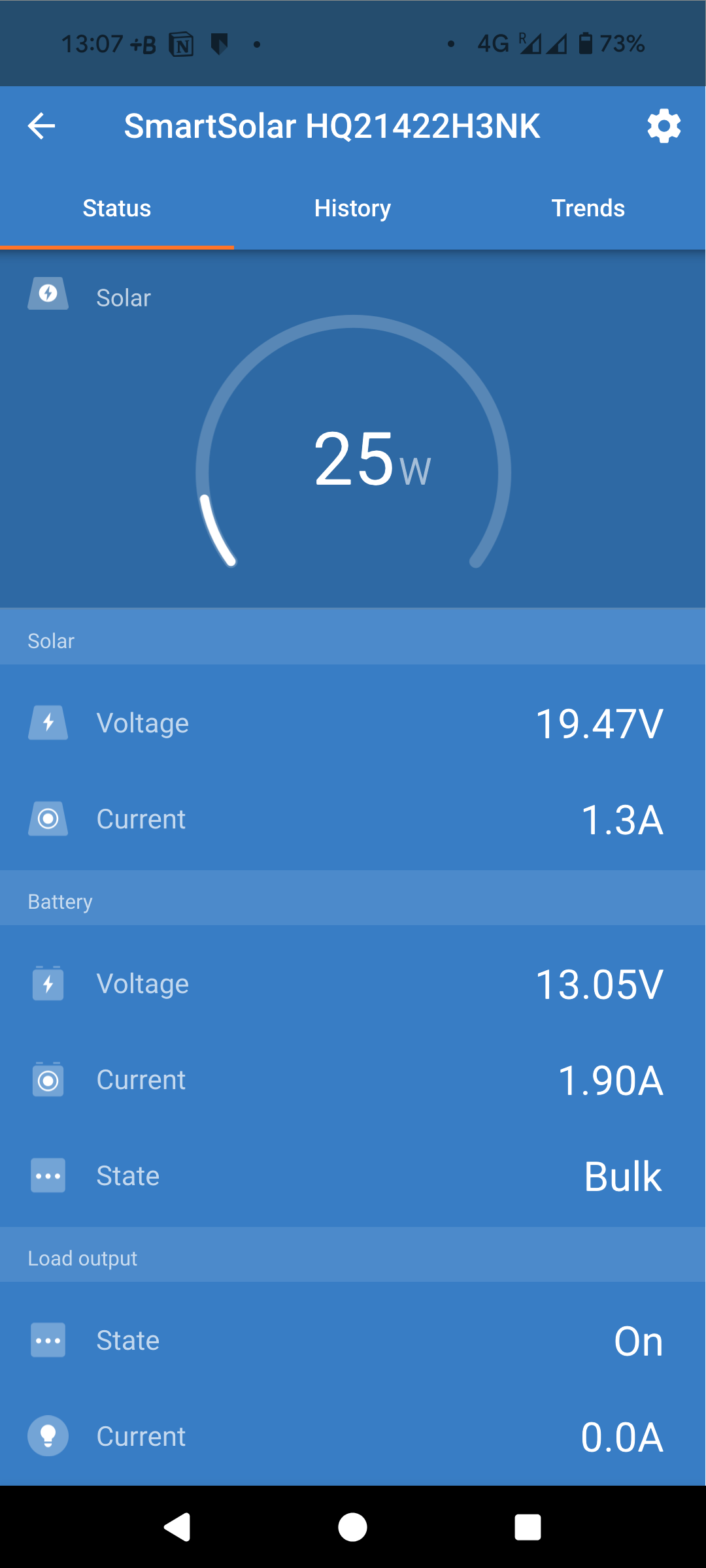how long can I run the fridge?
As a simple experiment, I’ve left the refrigerator running in Jean-Luc, our camper van. We have a 220W solar module on the roof that can maintain the battery, but it doesn’t get direct sunlight for very long in the alley our house is on in Amsterdam. Its a good “not-so-ideal” case - some sunlight, mostly shading.
Below is a chart from the Victron charge controller Android app, with my markups in green. The charge controller is connected to the camper battery and is fed by a 220W solar module on the roof.

I parked the van with a full battery charge on the evening of Monday, the 18th after a weekend trip (see “parked at home”), but left the fridge running. The slope of the blue line indicates the voltage on the battery as it drains due to the load from the fridge. Eyeballing the chart, it looks like about 0.3 v/24 hours. Yesterday morning, on the 21st (Thursday) I decided to turn off the fridge and let the battery recover. So it lasted 2 days and 3 nights, or about 60 hours, and the battery dropped about 1v. I think we could have run it another 12 hours, especially if there was some sunlight (there was!) so that’s the answer to my short study:
72 hours if we get some sunlight
48 hours of darkness (or covered parking, or shade)
This is okay performance, and it allows camping off grid for a weekend1. I will hopefully follow up in about a week as I see how long it takes the meager sunlight hitting the van to recharge the battery. Someday we will upgrade to LiFePO4 batteries and we will be able to go longer.
the longer story
The full chart gives me a chance to tell a longer story about debugging a charging problem we’ve had since this summer2.
Last weekend my wife and I took a weekend trip to Dörenther Klippen, near Münster. On Aug 15, on the far left edge of the chart (home ac), to prepare for the trip, I connected the van to AC power 3 to make sure the batteries were charged.
It worked, the charger that is, when I plugged it in. This was a good sign. By worked, I mean that it wasn’t clicking. The charger has a relay that disconnects the charging circuit if the voltage across the battery is too low, indicating a bad battery.
And why was this a good sign? Because we had been experiencing an intermittent charging issue since our trip to Finland in July. We also had some other issues4 that started after I made some changes5 back in March. So the broader context of all of this me mucking about with the power system that was factory installed in our camper.
Back to the 15th, if you look at the blue line in the chart (labeled “home ac (before repair)”), it doesn’t really show a healthy charging system. It has an arc, almost like a solar yield, but that’s just a coincidence.
When I returned in the morning of the 16th, the AC charger was doing the “click-click” of repeatedly connecting and disconnecting its charging relay, a sign it was reading low voltage again.
So this time I started poking around in the wiring harness under the front of the passenger-side seat, where most of the 12v wiring comes together. Including where I attached my modifications, as well as the custom solar.

Back in March I left this ground lug disconnected, which terminates a brown wire and a black wire. I haven’t traced both wires (yet), but one of them leads to the AC charging system. So it was my fault!
Also it explains the intermittent behavior and the weird voltage readings. Sometimes the lug would happen to touch the ground bar (or any other exposed metal) and provide a good enough path to ground for things to work. But when we were waiting to board the ferry in Finland, and the Westfalia camper controller was shutting down the fridge because it thought the battery voltage was very low.
Below the Westfalia system reports 10.3v, the solar charge controller reports 13.05V. I recorded this on July 16, while we were having the issue. At the time I power cycled the 12V system (there is a disconnect switch under the drivers seat) and the problem resolved.


Anyhow, mystery solved. Apparently, I didn’t reattach this to the ground bus, which is a pretty serious mistake. I also didn’t think to test the AC charger when I made the changes.
Instead of starting to prep the van, I went to get the tools I needed to fix this oopsie. Stair goal!6 I re-attached the lug and the charger clicked once and started working. In retrospect, the above voltage mismatch was a pretty obvious clue that something like this was wrong.
-
The lighting in the van is LED and has a neglible load on the system. We have a ventilation fan (a Maxxfan) in the rear, which draws a steady low load when the interior of the van warms up. Other intermittent loads are from usb ports to charge phones and laptops, and anything we plug into the 12V auxiliary port. Also the water pump for wash water (kitchen and bathroom), and the boiler, which burns diesel from the engine tank to heat wash water and heat the van interior, and needs 12v to operate. ↩
-
I’ve customized the factory DC power system from Westfalia with a 220W solar module and a Victron charge controller. I’ve also extended the DC power system with my own power distribution unit, to power lighting and other customizations of my own.
In addition, we have a Maxxfan ventilation unit replacing the skylight in the back, which can be set to run a fan based on interior temperature. This keeps the air moving inside, which is a life saver on hot days.
The camper has two 95 Ah AGM batteries, located under the front passenger seat, that can be charged in three ways:
- The engine alternator, if the van engine is running. This is connected using a high-current relay controlled by a voltage sensor, located in the front base of the front passenger seat.
- The AC charger, located on the rear base of the driver’s seat. This is available when the van is connected to “shore power.”
- The solar charge controller, active when there is sunshine on the rooftop solar module.
All three are connected, in parallel, to the battery. The AC charger and the alternator won’t be connected at the same time (and an alarm sounds if you start the engine while the shore power is plugged in!).
The AC charger and the alternator charger are connected by a Westfalia controller, presumably based on the voltage of the battery and the voltage of the engine DC system, which is separate from the camper van DC system. When the engine DC is higher than the battery voltage, the charging relay closes.
A simpler and common design is to close the charging relay whenever the ignition is engaged, instead of using a voltage sensor. ↩
-
This involves dangling our extension cable out of the 2nd floor window, down 2 stories to the sidewalk. Stair goal!6 ↩
-
We also have an intermittent issue with the electric step that extends under the side door, where the “step extended” alarm beeps even though the step is not extended. This will be the source material for a series of posts I hope to write. ↩
-
The “changes” that I mentioned consists of the addition of an over-engineered, relay-controlled auxiliary 12v DC power system, which was installed to power our “chemtrails” ground-effect lighting under the camper. ↩
-
My tools are in my office in the attic of our four story Amsterdam home. I have to climb 47 steep dutch stairs up and down, logged by my smartwatch. Hence, stair goal! and tired legs! ↩ ↩2